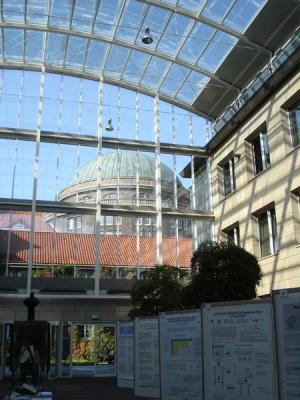Conference blogging
One of the fruitful application of blogs in the life sciences is to provide realtime coverage of conferences. Summaries and reviews of scientific meetings have been a traditional part of the scientific journals such as the Trends-series by Elsevier. However, they usually appear several months after the closing of the conference and often do not provide insights beyond the abstracts book, as they rather attempt to make everyone happy rather than focussing on the highlights.
Blogs can emphasize outstanding presentations immediately, and allow for a more independent view of the conference, even if it is biased by the personal preferences of their authors. Smaller workshops, which might produce interesting outcomes from panel discussions usually lack media coverage and could use blogs (or wikis) to disseminate results. The matter is not completely free of complications - some meetings are "closed meetings" and implement strong limitations on the media coverage. Bloggers need to be aware of that, even though most would not identify themselves with The Media. However, most organizations running scientific conferences would probably appreciate "live" coverage.
Some conferences were already covered by bloggers: nodalpoint's Greg Tyrelle featured the ISMB 2005, for instance. Free Association, the blog of the editors of Nature Genetics is currently providing coverage of the Third Seattle Symposium in Biostatistics: Statistical Genetics and Genomics . I will participate in a proteomics workshop next week and will cover the meeting to some extent here.
It would be helpful if we would create a repository (some blog or wiki) that would provide links to ongoing coverage of conferences by bloggers, possibly in a similar fashion to the TravelBlog.
Blogs can emphasize outstanding presentations immediately, and allow for a more independent view of the conference, even if it is biased by the personal preferences of their authors. Smaller workshops, which might produce interesting outcomes from panel discussions usually lack media coverage and could use blogs (or wikis) to disseminate results. The matter is not completely free of complications - some meetings are "closed meetings" and implement strong limitations on the media coverage. Bloggers need to be aware of that, even though most would not identify themselves with The Media. However, most organizations running scientific conferences would probably appreciate "live" coverage.
Some conferences were already covered by bloggers: nodalpoint's Greg Tyrelle featured the ISMB 2005, for instance. Free Association, the blog of the editors of Nature Genetics is currently providing coverage of the Third Seattle Symposium in Biostatistics: Statistical Genetics and Genomics . I will participate in a proteomics workshop next week and will cover the meeting to some extent here.
It would be helpful if we would create a repository (some blog or wiki) that would provide links to ongoing coverage of conferences by bloggers, possibly in a similar fashion to the TravelBlog.
spitshine - 2005-12-04 21:43


